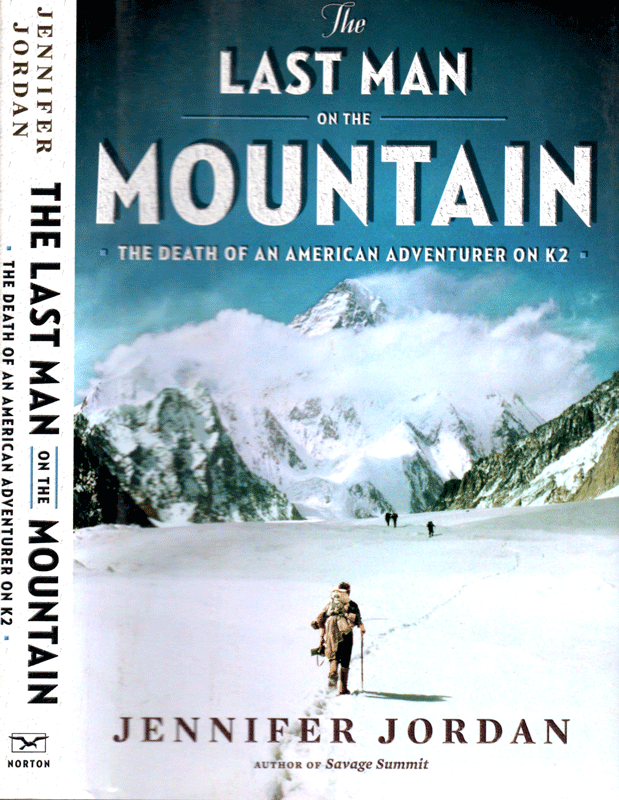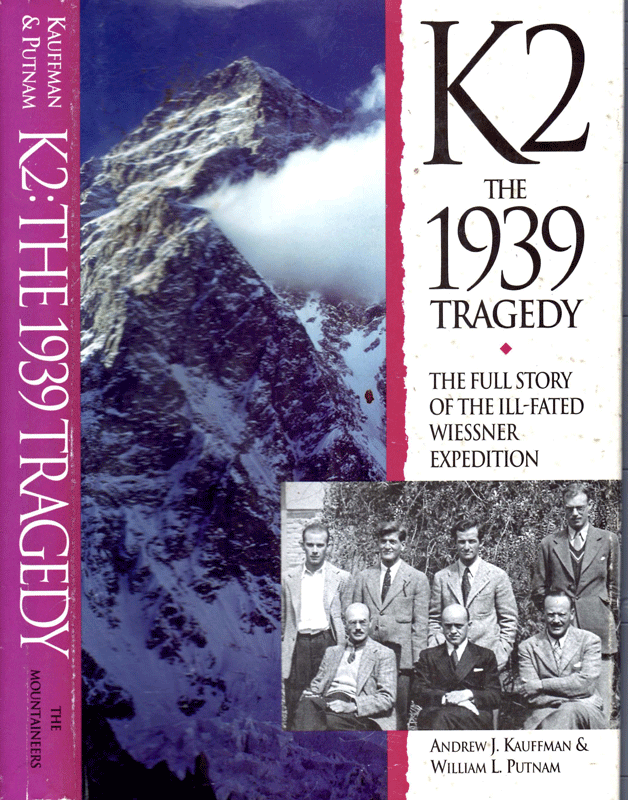

Other errors:Dudley Wolfe, who died high on K2 on the 1939 American expedition, has not been forgotten, but he has been neglected and patronized. He has been portrayed as clumsy and overweight, an aristocrat invited to the mountain only because of his wealth. While his sturdiness on the peak has evoked admiration, it has often been accompanied by the charge that he was virtually hauled up by the exceptionally strong leader, Fritz Wiessner. This description has some accuracy, but it is only a partial view. Jennifer Jordan has provided the fullest portrait to date of Dudley Wolfe; we are in her debt for her account.
The Dudley Wolfe who emerges from this book is a gentle and generous man, and an unfulfilled one. In World War I, “While other men were shooting themselves in the foot or leg to get out of combat, Dudley volunteered for some of the worst duty possible.” After the war he returned to Harvard, became a skilled yachtsman, and started to climb mountains. He married the athletic and wealthy Alice Damrosch, who seemed the perfect match. But there was something unsettled in Dudley, and he sought to end the marriage before he accepted Wiessner’s invitation to K2.
On the mountain, his performance belied his weak reputation, and even his detractors liked him. Except for Wiessner, he was the only American to climb high, where he stayed in good health and spirits for many weeks. Finally the altitude caught up with him. He died alone in his tent at nearly 25,000 feet. His remains were eventually swept down the mountain, where Jennifer Jordan found them in 2002.
The descriptions of Wolfe are the best thing in Jordan’s book. Her account of the climb itself is questionable. The recriminations over this expedition were bitter, and reverberate to this day, after the death of all the participants. Almost everyone has been blamed for the bitter outcome, in which Wolfe and three Sherpas died. Besides the very welcome picture of Wolfe, Jordan has not much to add to this sad story. She relates the climb in a vivid narrative, which makes the book extremely readable. But the readability comes at a price: she rarely pauses to tell us where her dramatizations come from. Her preface says that she uses “direct quotes, which I gathered from journals, letters, books, and witnesses,” and italicized conjectured speech and thoughts. One can’t quarrel with the italics, but other quotations are infrequently documented, only rarely supported by a footnote. And there are unquoted passages like this: “Tony [Cromwell] strutted about, officiously checking his clipboard...” Strutting, officiously--who says?
At times, Jordan’s grasp of mountaineering history and practices seems uncertain. She makes a number of errors. Some are minor, but it is unsettling to read of climbers rappelling each other down a cliff. And does she really think that Bill House led his famous chimney (in 1938) without a rope? (He used pitons as well as a rope, belayed by Bob Bates.) Jordan describes this alleged achievement as a “free ascent,” and one wonders how she defines the term. Earlier she writes of a climb being done “‘free’--without protective gear anchoring them to the rock.”
In view of the continuing rancor over this expedition, it is unfortunate that Jordan’s text nowhere engages its main predecessor: K2 the 1939 Tragedy, by Kauffman and Putnam (1992). She lists the book in her bibliography and has Putnam on her interview list, but her only references to the authors omit even their names. In the 1993 American Alpine Journal, Charles Houston, to whom Jordan has dedicated both her books, calls The 1939 Tragedy "a major contribution to mountaineering history.”
That book, which is far better documented than Jordan’s, springs from a disillusionment with Wiessner, about whom the authors had planned a biography, and a corresponding resurrection of the reputation of Jack Durrance. Durrance had long been blamed for stripping the mountain of its supplies, with fatal consequences. Relying heavily upon Durrance’s recently revealed diaries, Kauffman and Putnam place the blame elsewhere, partly upon Wiessner himself. But if they are critical of Wiessner, Jordan is much more so. She acknowledges, as everyone must, his prodigious climbing skills. Otherwise she sees him as an autocratic womanizer who wants the summit so that he can be famous and marry a wealthy widow.To be sure, there are no American heroes in Jordan’s book, except Wolfe. Durrance comes off badly too. Apart from his selfless ministrations to a very ill teammate, he is depicted as childish and self-absorbed and, like Wiessner, giving scant thought to Wolfe once he had been given up for lost.
Durrance’s role is puzzling. He had the strongest climbing record of anyone but Wiessner, yet felt repudiated by him from their first shipboard contact on the way to India. Kauffman and Putnam state that the two men had never met before, but Jordan points to an earlier training weekend together in the Shawangunks. She argues that Wiessner was keen to have Durrance on K2, even if disappointed by the withdrawal of the strong mountaineer, Bestor Robinson. In any case, the two men become estranged--less during the expedition than in its bitter and apparently endless aftermath. Durrance was forever scarred; one of the saddest parts of the book is the account of his later years.
The 1939 disaster is really less mysterious than controversial. We know a lot more about what happened to Wolfe and the heroic Sherpas who tried to save him than we do about Mallory and Irvine on Everest, or Boardman and Tasker on that peak years later. What is uncertain is less what was done than why: why was Wolfe left at Camp VII, after so many days at altitude? Why did Cromwell (apparently) order lower camps stripped? Why did so many of the party leave base camp before everyone was accounted for? And, afterwards, why did Durrance withhold his diary for so many years?
There is finally one tantalizing conjecture: what if, on that fateful July 19, Wiessner had turned right onto the ice instead of left onto the rocks? The route he rejected became the regular one thereafter. Wiessner and Pasang Lama would almost surely have made the top, which would have been an astonishing achievement at a time when no other 8000-meter peak had been climbed. Then in all likelihood they would have escorted Wolfe down to base camp, and we would not still be arguing about what happened and why. Wiessner thought the ice route, now known as the Bottleneck, to be dangerous. He was right: a serac collapse there in 2008 led to many more fatalities than were incurred in 1939. But he might well have succeeded on it in 1939.
We may never have a truly definitive account of this fateful climb. Jordan’s is certainly not it. But the book paints a comprehensive and endearing picture of Dudley Wolfe--a picture that was long overdue.
--Mummery did not have Sherpas on Nanga Parbat; (p. 22)
--the 1934 Nanga Parbat fatality toll was 10, not 26; (22)
--Hadow of the Matterhorn was Douglas, not George; (59)
--Wiessner was not in the Gunks when he first sighted the Gunks; (68)
--Wiessner and Pasang Lama’s high point was not the highest yet reached without supplementary oxygen; (191)
Jordan also appears to confuse Hans Kraus the climber with Hans P. Kraus, the rare book dealer.
There are also a couple of mistakes in the acknowledgements and bibliography.
This review appeared in slightly different form in The American Alpine Journal, 2011.
Return to climbing page.
Return to travel page.
Return to home page.

